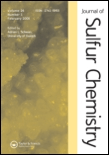
Journal of Sulfur Chemistry
Scope & Guideline
Connecting Researchers in Sulfur Science
Introduction
Aims and Scopes
- Catalysis and Green Chemistry:
Research on the development of novel catalysts, particularly those that are environmentally friendly, such as magnetic nanoparticles and organocatalysts, is a core focus. This includes studies on their efficiency in various reactions, including desulfurization and organic transformations. - Synthesis of Sulfur-Containing Compounds:
The journal publishes articles detailing innovative synthetic methodologies for sulfur-containing compounds, including thiazoles, thioureas, and sulfonamides. This encompasses both conventional and modern synthetic techniques, including microwave-assisted and solvent-free methods. - Characterization and Theoretical Studies:
There is a significant emphasis on the characterization of sulfur compounds using spectroscopic, crystallographic, and computational methods. Theoretical studies, particularly those involving density functional theory (DFT), are frequently used to understand the properties and reactivity of sulfur compounds. - Biological and Medicinal Applications:
Research addressing the biological activities of sulfur compounds, including antimicrobial, anticancer, and antioxidant properties, is prominently featured. This includes studies that explore the pharmacological potential of novel sulfur-containing compounds. - Environmental and Industrial Applications:
The journal includes research related to environmental chemistry, particularly the development of methods for the detection and removal of sulfur-containing pollutants from fuels and other sources, highlighting the industrial relevance of sulfur chemistry.
Trending and Emerging
- Nanomaterials and Nanocatalysts:
There is a significant trend towards the use of nanomaterials, particularly magnetic nanoparticles and composites, in catalysis and environmental applications. This includes the development of reusable and efficient catalysts that enhance reaction rates and selectivity. - Green Chemistry and Sustainability:
The journal is increasingly featuring research on green chemistry principles, such as solvent-free synthesis and the use of renewable resources for the preparation of sulfur compounds. This reflects a growing commitment to sustainable practices in chemistry. - Advanced Characterization Techniques:
Emerging themes include the use of advanced characterization techniques, such as molecular dynamics simulations and quantum chemical calculations, to gain deeper insights into the properties and reactivity of sulfur compounds. - Biological and Pharmaceutical Applications:
There is a rising interest in the biological implications of sulfur compounds, particularly their potential as therapeutic agents. Research focusing on the anticancer and antimicrobial properties of sulfur-containing molecules is becoming more prominent. - Electrochemistry and Sensor Development:
The development of electrochemical sensors for detecting sulfur gases and compounds is gaining traction, reflecting the journal's focus on practical applications of sulfur chemistry in environmental monitoring and safety.
Declining or Waning
- Traditional Synthetic Methods:
There has been a noticeable decrease in publications focusing solely on traditional synthetic methods for sulfur compounds, as researchers increasingly adopt greener and more efficient techniques such as microwave-assisted synthesis and solvent-free conditions. - Desulfurization of Fossil Fuels:
Although desulfurization remains a relevant topic, there appears to be a waning interest in conventional methods of desulfurization in favor of more innovative and sustainable approaches, reflecting broader trends in environmental chemistry. - Basic Theoretical Studies:
The journal has seen a decline in basic theoretical studies that do not directly contribute to practical applications or novel methodologies, as the focus shifts towards research with immediate relevance to industry and biological applications.
Similar Journals

Results in Chemistry
Unlocking Innovations in ChemistryResults in Chemistry is a prominent journal published by Elsevier, dedicated to fostering innovation and disseminating cutting-edge research in the field of chemistry. With an ISSN of 2211-7156, this open-access journal has been committed to making scientific knowledge widely available since 2019, aligning with the global trend towards accessibility in research. Based in the Netherlands, it features interdisciplinary studies that span the breadth of general chemistry, contributing significantly to the academic dialogue within the scientific community. Despite currently holding a Q3 ranking in the miscellaneous category of chemistry and occupying the 228th position out of 408 in Scopus rankings, the journal is poised for growth, aiming to enhance its impact and visibility. Researchers, professionals, and students alike will find invaluable resources and insights within its pages, making Results in Chemistry an essential platform for those looking to stay abreast of advancements and trends in chemistry research up to the year 2024.

INDIAN JOURNAL OF HETEROCYCLIC CHEMISTRY
Championing Excellence in Heterocyclic StudiesINDIAN JOURNAL OF HETEROCYCLIC CHEMISTRY, published by CONNECT JOURNALS, is a vital resource in the fields of organic chemistry and biochemistry, aiming to advance research and promote innovation within the realm of heterocyclic compounds. Established in 1996, this journal has successfully converged into an influential publication with a commitment to disseminating high-quality, peer-reviewed research articles that enhance the understanding of heterocyclic chemistry applications. Although it currently holds a Q4 quartile ranking in both biochemistry and organic chemistry according to the 2023 categorizations, its broader contributions to the scientific community should not be underestimated, as it seeks to support the ongoing dialogue among researchers, professionals, and students. The journal operates from Ghaziabad, India, providing open access to its publications, thereby fostering a collaborative and informative environment for its international readership. With an ISSN of 0971-1627 and a special focus on contemporary challenges and developments in the field, the INDIAN JOURNAL OF HETEROCYCLIC CHEMISTRY is poised to make a significant impact as it continues to evolve through 2024 and beyond.

RUSSIAN CHEMICAL REVIEWS
Advancing Chemistry Through Insightful ReviewsRUSSIAN CHEMICAL REVIEWS, published by the esteemed ND Zelinsky Institute of Organic Chemistry, RAS, stands as a prominent platform for disseminating high-quality research in the diverse field of chemistry. With an ISSN of 0036-021X and an E-ISSN of 1468-4837, this journal has earned its place in the Q1 quartile of Chemistry (miscellaneous) for 2023, reflecting its outstanding impact and rigorous peer-review process. The journal encompasses a wide array of topics within chemistry, providing critical reviews that advance understanding and foster collaboration among researchers, professionals, and students globally. With its consistent publication since 1970, RUSSIAN CHEMICAL REVIEWS not only serves as a valuable resource for the latest advancements in the field but also plays a crucial role in shaping future research directions. The journal is based in the Russian Federation, with its office located at 47 Leninsky Pr, Moscow 119991, RUSSIA. As an essential reference for those in the chemical sciences, it provides an ideal avenue for authors looking to publish impactful reviews that contribute to the broader scientific community.

JOURNAL OF HETEROCYCLIC CHEMISTRY
Illuminating the Path of Heterocyclic DiscoveriesJournal of Heterocyclic Chemistry, published by Wiley, stands as a key resource in the field of organic chemistry, offering in-depth research articles and insights spanning from 1966 to 2024. With its strong Scopus ranking of #83 out of 211 in the Organic Chemistry category, placing it in the 60th percentile, the journal maintains its significance and relevance within the academic community. Although it does not currently offer open access options, it provides extensive coverage of heterocyclic compounds, which are vital to various applications in pharmaceuticals and material sciences. The journal's commitment to high-quality research is further reflected in its classification as Q3 in the 2023 quartiles for Organic Chemistry. Researchers, professionals, and students alike will find valuable contributions to the intricate studies of heterocycles, enhancing their understanding and exploration of this fascinating area of chemistry.

CHEMISTRY OF NATURAL COMPOUNDS
Illuminating the Path of Natural Compound ApplicationsChemistry of Natural Compounds is a premier academic journal dedicated to the intersection of natural products and modern chemistry, published by Springer. Since its inception in 1965, this journal has published innovative research articles, reviews, and discussions that focus on the chemistry and biochemistry of natural compounds, with an emphasis on their applications in various fields including medicine, agriculture, and environmental science. Recognized for its contributions to the scientific community, the journal is indexed in key databases and holds a respectable impact factor that underscores its relevance in the academic landscape. Currently ranked in the Q3 category across multiple disciplines, including Biochemistry, Genetics and Molecular Biology, Chemistry, and Plant Science, it serves as a critical resource for researchers and professionals aiming to deepen their understanding of the complex interactions between natural compounds and biological systems. While not an open-access journal, Chemistry of Natural Compounds provides valuable insights and essential findings that can aid in advancing both theoretical and applied sciences for researchers, students, and industry practitioners alike.
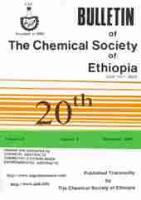
BULLETIN OF THE CHEMICAL SOCIETY OF ETHIOPIA
Exploring the Frontiers of Chemistry with Every PublicationBULLETIN OF THE CHEMICAL SOCIETY OF ETHIOPIA (ISSN: 1011-3924; E-ISSN: 1726-801X), published by the Chemical Society of Ethiopia, serves as a pivotal platform for the dissemination of innovative research and developments within the field of chemistry. Since its inception in 1996 and now an open access journal since 2012, it has provided researchers, academics, and students with unrestricted access to critical studies and findings, thus fostering collaboration and the advancement of knowledge in the discipline. The journal's current standing in the Q3 quartile in the 2023 Chemistry category underlines its commitment to maintaining high academic standards, while its Scopus ranking, positioned at #250 out of 408 in general chemistry, showcases its growing influence and contribution to the scientific community. Hailing from Ethiopia and targeted toward a global readership, the journal aims to highlight local and international research, engaging scholars and practitioners alike in discussions that propel the science of chemistry forward.
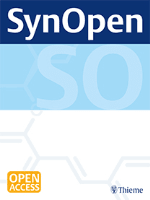
SynOpen
Catalyzing Ideas, Enriching ResearchSynOpen is an esteemed open-access journal published by GEORG THIEME VERLAG KG, based in Germany, dedicated to advancing the fields of Biomaterials, Catalysis, Materials Science, and Organic Chemistry. Since its inception in 2017, the journal has established itself as a vital platform for researchers wishing to disseminate their findings in a rapidly evolving scientific landscape, earning a commendable Q2 ranking in Materials Science (miscellaneous) and Q3 in other key categories for 2023. With an increasing impact on its disciplines, SynOpen aims to foster interdisciplinary collaboration and innovation by providing unrestricted access to high-quality research, thus promoting a broader reach and visibility for authors. Scholars, professionals, and students alike can benefit from the comprehensive range of topics covered, as the journal's commitment to presenting cutting-edge studies and methodologies positions it as a crucial resource for contemporary scientific inquiry.
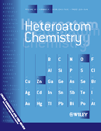
HETEROATOM CHEMISTRY
Pioneering New Frontiers in Heteroatom ResearchHeteroatom Chemistry is a prominent open-access journal dedicated to advancing the field of heteroatom chemistry, with a particular focus on the chemistry of elements other than carbon in organic compounds. Published by Wiley-Hindawi, this journal provides researchers, professionals, and students with a platform to disseminate and access novel research findings related to the synthesis, properties, and applications of heteroatom-containing compounds. Since its inception in 1990 and gaining open access status in 2019, the journal has fostered academic collaboration and innovation throughout its converged years, although it currently holds a category quartile ranking of Q4 in Chemistry (miscellaneous) and ranks #319 out of 408 in general chemistry within Scopus. With its commitment to high-quality research and broad accessibility, Heteroatom Chemistry is poised to be an essential resource for anyone looking to explore the rich and varied applications of heteroatom chemistry in diverse scientific fields.

RUSSIAN CHEMICAL BULLETIN
Your Gateway to Innovative Chemical Research.RUSSIAN CHEMICAL BULLETIN, published by SPRINGER, serves as a pivotal resource in the field of general chemistry, covering a wide array of topics that impact both theoretical and applied chemistry. With an ISSN of 1066-5285 and a presence since 1993, this journal provides a platform for disseminating significant research findings, practical applications, and novel methodologies within the broader chemistry community. While it currently holds a Q3 ranking in the Chemistry (miscellaneous) category and occupies the 230th position out of 408 in the Scopus rankings, its reputation continues to grow, fostering collaboration and innovation among researchers and professionals alike. Although the journal does not offer an open-access model, it is committed to making findings accessible within the academic community, ensuring that valuable insights can inform future research. With an anticipated convergence of studies extending to 2024, the RUSSIAN CHEMICAL BULLETIN remains an essential reference for those dedicated to advancing chemical science.
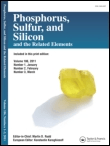
PHOSPHORUS SULFUR AND SILICON AND THE RELATED ELEMENTS
Catalyzing Knowledge in Biochemistry and BeyondPHOSPHORUS SULFUR AND SILICON AND THE RELATED ELEMENTS, published by Taylor & Francis Ltd, is a distinguished journal dedicated to advancing knowledge in the fields of Biochemistry, Inorganic Chemistry, and Organic Chemistry. Established in 1989, the journal has carved a niche in the scientific community by offering a platform for the publication of innovative research that explores the chemistry and applications of phosphorus, sulfur, silicon, and related elements. With an ISSN of 1042-6507 and an E-ISSN of 1563-5325, this journal provides access to valuable insights, albeit without open access options. Despite being positioned in the fourth quartile of its categories (Q4), it remains an essential resource for researchers, professionals, and students seeking to expand their understanding of these pivotal elements and their interactions. With a publishing horizon extending to 2024, the journal invites contributions aimed at pushing the boundaries of chemistry and fostering interdisciplinary dialogue.